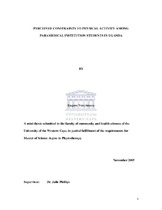| dc.contributor.advisor | Phillips, Julie | |
| dc.contributor.author | Nizeyimana, Eugene | |
| dc.contributor.other | Dept. of Physiotherapy | |
| dc.contributor.other | Faculty of Community and Health Sciences | |
| dc.date.accessioned | 2013-05-27T09:02:43Z | |
| dc.date.available | 2007/03/15 15:38 | |
| dc.date.available | 2007/03/30 | |
| dc.date.available | 2013-05-27T09:02:43Z | |
| dc.date.issued | 2005 | |
| dc.identifier.uri | http://hdl.handle.net/11394/229 | |
| dc.description | Magister Scientiae (Physiotherapy) - MSc(Physio) | en_US |
| dc.description.abstract | Research has clearly shown that all individuals will benefit from regular physical activity. Unfortunately, young adults including college and university students are not physically active on a regular basis worldwide. In the developing world particularly in Sub- Saharan Africa, physical inactivity along with tobacco use, poor diet and nutrition are increasingly parts of today’s lifestyle. Physical activity declines with age and the most important decline appear to be during the transition period from high school to university and during university years. The aim of this study was to assess the level of physical activity, to investigate the perceived constraints to physical activity and to determine whether socio-demographic characteristic have an influence on participation in physical activity and perceived constraints to physical activity among paramedical institutions students in Uganda. A cross-sectional study with descriptive quantitative design was conducted. Four hundred (400) paramedical institution students were selected using a stratified random sampling technique. A self-administered questionnaire adopted from the literature was used to collect the data. A response rate of 90% was obtained. Descriptive and inferential statistics using the statistical package for social sciences were used to analyze the data. The relationships and associations between different variables were determined by carrying out significant tests using chi-square tests. Alpha level was set at 0.05. The mean age of the sample was 22.44 years (SD = 2.03). Males constituted 73.9% and females constituted 26.1% of the sample. Students from eight (8) health professional courses participated in the study. Over half (59%) of participants were classified as physically active and 41% were classified as inactive or sedentary. For male participants, lack of the right equipment to exercise and wanting to do other things in their free time were perceived as the major constraints to physical activity. For female participants, lack of motivation and tiredness after exercise were perceived as the major constraints to physical activity. The findings of this study demonstrate that there is an influence of socio-demographic characteristics such as gender, year of the study and different departments/schools on participation in physical activity and perceived constraints to physical activity. They also indicate the need of health promotion intervention aiming at promoting physical activity among paramedical institution students in Uganda. | en_US |
| dc.language.iso | en | en_US |
| dc.publisher | University of the Western Cape | en_US |
| dc.subject | Physical fitness for youth | en_US |
| dc.subject | Uganda | en_US |
| dc.subject | Exercise | en_US |
| dc.subject | Physiological aspects | en_US |
| dc.subject | Health aspects | en_US |
| dc.subject | College students | en_US |
| dc.subject | Health and hygiene | en_US |
| dc.title | Perceived constraints to physical activity among paramedical institution students in Uganda | en_US |
| dc.type | Thesis | en_US |
| dc.rights.holder | University of the Western Cape | en_US |
| dc.description.country | South Africa | |

